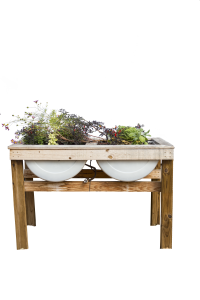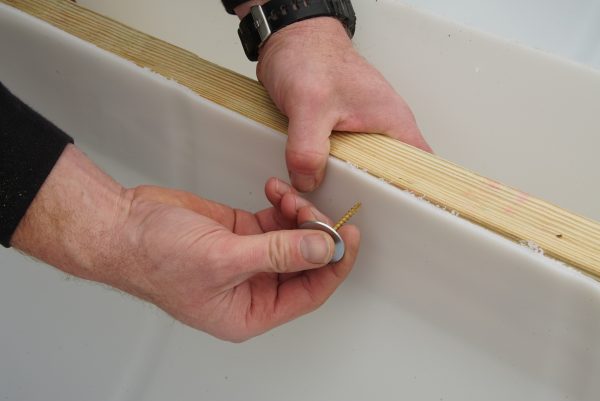Construction of Table Gardens
Everyone should have the opportunity to garden, however,  traditional gardening at ground level can be physically demanding on your knees and
back. Often, it requires bending, stooping and kneeling, which can be challenging
for some people. Bringing the planting bed up to waist height can provide a more comfortable
opportunity to garden. It also provides head-on access for people who sit in wheelchairs
and allows their knees to go under the raised planter sitting straight.
traditional gardening at ground level can be physically demanding on your knees and
back. Often, it requires bending, stooping and kneeling, which can be challenging
for some people. Bringing the planting bed up to waist height can provide a more comfortable
opportunity to garden. It also provides head-on access for people who sit in wheelchairs
and allows their knees to go under the raised planter sitting straight.
Table gardens

have all the same benefits of other raised beds, such as improved planting media, good drainage and reduced weed encroachment. Table gardens are ideal for temporary gardening locations, poor soils, outdoor classrooms, paved areas and small patios.
Building a Table Garden
Materials
55-gallon plastic barrel (food grade)
140 inches 4×4-inch posts
322 inches 2×4-inch boards
216 inches of decking board
Several 1 5/8-inch screws
Several 2 ½-inch screws
Washers
Sand Paper
All-weather wood sealer
Tools
Reciprocating saw
Circular saw or miter chop
saw
Tape measure
Triangle
Clamps
Pencil
Drill with screw bit
Constructing Table Top
- Cut barrel in half – lengthwise, giving you 2 half barrels.
- Cut 2×4-inch board to length of barrel. You will need three of these lengths (A1, A2 and A3 on Figure 1).
- Using 1 5/8-inch screws, attach a 2×4-inch board (A1 & A2) to the outside of barrel 1, along the long cut edges. Use clamps to hold 2×4-inch board in place. Insert screws at point V (See Figure 1) from inside the barrel into wood and use washers to reinforce hole in barrel. (See Photo 1)
- Attach the second half barrel (barrel 2) to board A2. Again, use clamps to hold barrel in place and use washers and insert 1 5/8-inch screws from inside the barrel 2 into board A2 at Point V in Figure 1.
- Attach the third 2×4-inch board (A3) to the other side of the second half barrel (2), again using clamps, washers and insert 1 5/8-inch screws from inside the barrel into wood at Point V in Figure 1.
- Turn barrels upside down and set aside.
Figure 1.
Photo 1.
Constructing Table Legs
7. Cut 4×4-inch post to 36-inch length. You will need four of these posts (B on Figure 2). Thirty-six inches will be the height of the table; different lengths can be used to make a shorter or taller table, based on preference.
8. Using the reciprocating saw, notch out one end of each 4×4-inch post so that A1
and A3 will be supported by the 4×4-inch posts. See inset in Figure 2.
*Note – 2×4-inch boards are not true measurements; 2×4-inch boards are typically 1
½ x 3 ½ inches.
Figure 2.
9. Using 2 ½” screws, attach the notched end of the 4×4 post to each end of 2×4-inch boards attached to barrels (A1 & A3) at Point W in Figure 2. These will be the corner legs of the table. Take care that the edges of the 4×4-inch post and the 2×4-inch boards align at the ends; another board will be placed flush against these edges (C1 top & C2 top).
10. Measure the total width of the attached barrels with the attached wood to get
accurate measurement for C1 & C2 top and bottom boards in Figure 2. Measure from the
outside edge of one 4×4-inch board to the outside edge of the opposite 4×4-inch board,
across the two barrel halves. Measure both sides, as the two sides (C1 & C2) may be
different lengths.
11. Cut two 2×4-inch boards for the length of each table side (C1 top, C1 bottom, C2 top and C2 bottom).
12. Using 2 ½-inch screws at Point X in Figure 2 attach one of these cut 2×4-inch boards to each side of the table (C1 top & C2 top).
13. Using 2 ½-inch screws, attach remaining two 2×4-inch boards (C1 bottom & C2 bottom) to the inside of 4×4-inch legs (B) at points Y in Figure 2. The boards should rest firmly upon the barrels, in order to help support the weight of the barrels when the table is turned right side up. See Photo 2.
Photo 2.
Finishing Table Garden
14. Flip the entire table over so that it is right side up.
15. Insert 1 5/8-inch screws with washers from inside the barrel to attach each half barrel to C1 & C2 tops at Point Z.
16. Drill holes in bottom of barrels for drainage. The number and size of holes for drainage will vary, depending on the soil media and plant selection. It is easier to increase drainage later by drilling more holes in the bottom of the barrel after planting than it is to reduce drainage.
17. Use triangle to make mitered corners, and 1 5/8-inch screws to frame the top of the table with decking boards. See Figure 3 and Photo 3.
18. Sand smooth.
19. Paint or weather seal wood.
20. After the paint has dried, fill the barrels with potting soil.
21. Plant!
Figure 3.
Photo 3.
Planting Your Table Garden
Table gardens are ideal for most annual vegetables and herb plantings. Due to the elevation, garden tables are not recommended for growing taller vegetables, such as corn and taller okra varieties, as the crop will be out of reach and the plant will be exposed to more wind. In addition, the growth habit of heavy vines, such as watermelon and pumpkins are not ideal for table gardens.
A table garden is similar to a container garden and may dry out faster, requiring more watering than if you were to plant the same plants in the ground. The benefit to this is they will also drain faster during heavy spring rains.
Table 1. Ideal table gardening plants.
| Warm Season | Cool Season | Herbs | |
|---|---|---|---|
| Beans | Beets | Basil | |
| Eggplants | Carrots | Borage | |
| Peppers | Chard | Catnip | |
| Squash | Garlic | Chives (onion & garlic) | |
| Tomatoes | Kale | Cilantro | |
| Zucchini | Lettuce | Dill | |
| Onions | Fennel | ||
| Peas | Lavender | ||
| Radish | Lemon Balm | ||
| Spinach | Lemon Verbena | ||
| Turnips | Marjoram | ||
| Mint | |||
| Oregano | |||
| Parsley | |||
| Rosemary | |||
| Sage | |||
| Savory | |||
| Scented Geraniums | |||
| Thyme |
Other OSU Extension Gardening Publications
HLA-6004: Oklahoma Garden Planning Guide
Oklahoma Gardening Video https://youtu.be/ZDe3Yxc0nZc
Casey Hentges
Assistant Extension Specialist
Qing Lana Luo
Assistant Professor, Extension Landscape Architecture Specialist
Laura Payne
Extension Associate







